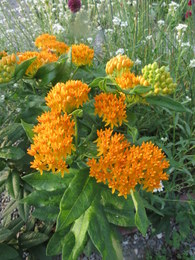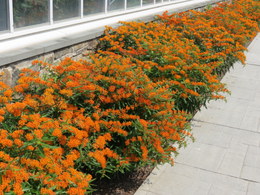Butterfly Weed
Growing Guide
Butterfly Weed (Asclepias tuberosa) is a perennial wildflower native to eastern and central North America and will do well in USDA Zones 3 to 10 and prefer full sun. Its other common name is butterfly milkweed and should not be confused with Butterfly Bush (Buddleia davidii) which is a tall shrub that is considered invasive in many areas.
It is in the broad milkweed family of more than 100 species. Milkweed is the host plant and the only food source for the Monarch caterpillars. If you want to see Monarch butterflies you should plant some milkweed. There are tropical milkweed plants that should not be planted outside of their native environment. Check with your local cooperative extension for the best native milkweed to plant in your area.
In addition to being deer resistant the beautiful orange flowers are a source of nectar for butterflies such as the Monarch, Tiger Swallowtail, Viceroy and Painted Lady, as well as many pollinators. It blooms midsummer through fall and will reach an average height of 12 to 24-inches and spread 12 to 18-inches wide.
Starting from Seed
Butterfly weed seeds can be started indoors 6 to 8-weeks before your last expected frost date.
Before planting, the seeds need to be put through a cold treatment process called stratification first. Put the seeds in the refrigerator for at least 6-weeks. This cooling process simulates how it would occur in nature.
Thinly sow the seeds 1/4-inch deep directly in the garden after the last frost. The plant will typically grow its foliage and taproot the first year and blooms will appear the next summer, but sometimes will bloom the first year.
You can also sow the seeds in the fall after frost occurs, but before the ground freezes, which will provide the natural cold stratification that is needed.
Sources: Burpee, Nature Hills Nursery, Park Seed
For more detailed information visit the seed starting page.
Soil Preparation
Plant your butterfly weed in full sun to part sun in a nice loose well-drained garden soil. It does best in a slightly acid soil with a pH range of 6.0 to 7.0.
Planting Butterfly Weed
Butterfly weed has a long taproot and established plants do not transplant well. Late spring after the last expected frost is the best time for planting.
Plant them 15 to 18-inches apart or in groups of 3 or 5 behind other shorter plants. Dig a hole as deep as the pot and twice as wide. To the soil you just removed add the same amount of good garden soil so you have a nice blend of new and native soil.
Take the plant out of the pot and gently loosen the root ball pulling away any roots that have grown in a circle around the pot.
Place the root ball in the hole with the growing crown of the plant even with or an inch higher than the surrounding soil. Gently spread out the roots and back fill the hole around the root ball leaving a shallow depression around your plant. Fill the depression with water to settle the soil around the roots adding more soil if necessary and water again. Water daily tapering off as the roots grow and get established.
A mass planting as a border is very attractive and will attract many butterflies.
Watering and Care
Butterfly weed is low maintenance and easy to care for. All you need to do is add a layer of mulch to help retain moisture and keep out competing weeds.
Your plant should get an inch of water each week and during dry spells give some water to keep the soil moist. They usually do not need any fertilizer, but a light side dressing of organic fertilizer can be placed around the plant in the spring.
Diseases and Pests
It does not have any serious disease or insect problems. Occasionally powdery mildew, leaf spot and rust may occur. Increase air circulation around the plants.
Aphids, milkweed bugs and Spider mites can be controlled by spraying the plant with water to knock them off.
For organic gardeners with serious problems, insecticidal soap or neem oil can be used.
In wet locations crown rot can be a problem.
Garden Spikes newsletters give you timely information once or twice a month. Subscribe Free to the Garden Times newsletter below.
Your email address will only be used to send you a newsletter and will never be sold. You can unsubscribe at any time.




